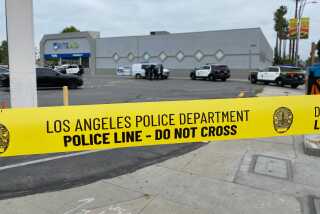Dallies’ Slaying Puts Focus on Safety of Officers : Dangers: Police renew talk about video cameras on patrol cars, gun control and traffic-stop procedures that may help save the lives of colleagues.
During briefings and shift changes, in meetings and hallway conversations, the slaying of a Garden Grove police officer intensified concern over officer safety at law enforcement agencies throughout Orange County on Wednesday.
“At the roll calls, it has been a major topic of discussion,” California Highway Patrol Officer Angel Johnson said. “The supervisors want the officers to be aware, and to be careful out there.”
The shooting death of veteran officer Howard E. Dallies Jr. during a traffic stop early Tuesday did more than cast a somber, chilling mood among other officers.
The attack has caused the Garden Grove Police Department to consider equipping more patrol cars with video cameras, which could provide an added measure of protection for officers and give investigators valuable clues if an officer is hurt.
And while Dallies’ death at the hands of an armed motorcyclist isn’t prompting changes in policy, it has prompted law officials to assail the easy availability of illegal guns and highlighted the dangers of seemingly routine traffic stops.
“A simple traffic violation may be something much more serious,” said Capt. Tom Lazar of the Costa Mesa Police Department. “A person may have just committed a violent crime, but you wouldn’t know it.”
The killing, said Santa Ana Police Chief Paul M. Walters, “makes everyone realize the dangers of policing. When it’s right next door, it really makes everybody pause for a moment and makes us realize we’re vulnerable. Even if you wear body armor, it doesn’t protect everybody.”
Dallies, 36, was wearing a bulletproof vest, but the fatal slug ripped into his midsection just below the chest protection. He did not, as he usually did, radio in before stopping the motorcyclist.
The shooting has caused particular concern at the CHP, where most of a patrol officer’s encounters with the public involve traffic stops.
Johnson said CHP officers normally don’t call in when they pull over a motorist because they make so many stops that the calls would jam the radio. CHP officers call in only when they have a particular reason, such as stopping a car with missing license plates, or a driver acting nervously.
Police officials said it’s not always possible to call, even for something as routine as a traffic stop.
“You can’t always call in, I know from my experience,” Laguna Beach Police Chief Neil J. Purcell Jr. said. “You don’t want to be sitting in your car with someone walking toward you. But on most car stops, there is ample time.”
Even before the recent shooting that claimed two policemen in Compton, Purcell had asked his City Council for funding to install video cameras in police cars.
“With the Garden Grove shooting and the one in Compton, they’re both clear examples that if those instances were videotaped, you would have seen the suspects clearly,” he said.
Other agencies, including the Sheriff’s Department and the Los Alamitos police, recently installed video cameras in their patrol cars.
The Garden Grove department was one of the first in Orange County to install video cameras in some of its patrol cars, but Dallies’ car did not carry that equipment.
“We just have it in a couple of cars; in hindsight, that might have been an interesting piece of evidence to have,” Garden Grove Capt. David Abrecht said.
Many chiefs said they would like to install the equipment, but the expense, at several thousand dollars per unit, was prohibitive. Their cities, they point out, are all facing severe budget problems.
Some police chiefs said the slaying illustrates how the ever-increasing number of guns in circulation--especially those obtained illegally--is threatening officers.
“The person (who shot Dallies) didn’t go out and buy his gun over the counter. He probably got his gun the same way he got the (stolen) motorcycle,” Costa Mesa Police Chief David L. Snowden said.
More to Read
Sign up for Essential California
The most important California stories and recommendations in your inbox every morning.
You may occasionally receive promotional content from the Los Angeles Times.










